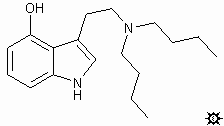| N - C | one carbon is methyl, there is only one way it
can be attached |
| Now you have been given two tennis balls: |
| N - C - C | two carbons is ethyl, there is only one way
you can attach them |
| Now you have been given three tennis balls: |
| N - C - C - C |
three carbons is propyl, this is one way they can be attached
(known as propyl) |
| But a second possibly emerges: |
|
the third tennis ball can touch the first rather
than the second ball (known as isopropyl) | |
| Now you have been given the fourth tennis
ball: |
| N - C - C - C - C | four carbon atoms is butyl,
this is one way they can be attached (known as normal butyl), |
|
the fourth ball can touch the first, this is another
way they can touch (known as secondary butyl) |
|
the fourth ball can touch the second, this is yet another
way they can touch (known as iso butyl, or i-butyl), |
| (of course, if the fourth ball touches the third,
you have the normal butyl as shown above) |
|
the third and fourth ball can touch the first one -- this is the
fourth way they can touch (known as tertiary butyl) |


